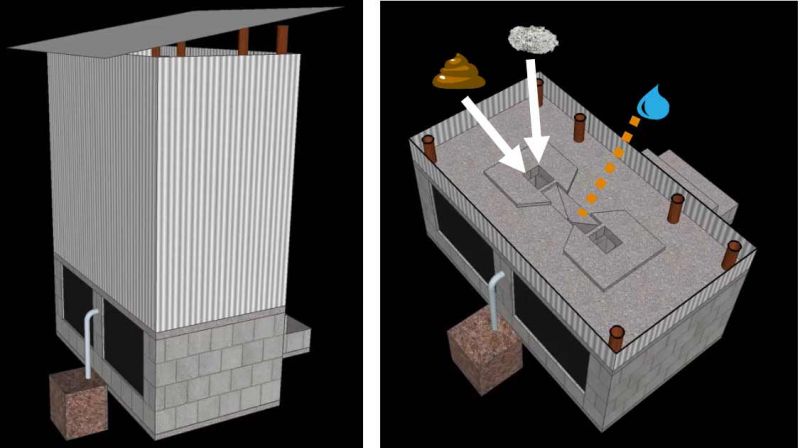Sustainable Emergency Sanitation – No Longer a Pipe Dream!
Published on by Water Network Research, Official research team of The Water Network in Technology
Sustainable toilets for prolonged emergency contexts are no longer a pipe dream!
How can we build sustainable and user-friendly toilet options for refugee camps? It’s an ongoing challenge and area of innovation for Oxfam – particularly in situations where poor ground conditions mean standard pit latrines can’t be dug.
The good news is the evidence is in. Sustainable toilets for prolonged emergency contexts are no longer a pipe dream!

DIAGRAM OF A URINE DIVERSION TOILET, Source: OXFAM
Urine diversion dry toilets
We now have confirmation, validated by the UNHCR Waste to Value Sanitation programme, that the urine diversion dry toilets (UDDTs) which Oxfam’s been trialling since 2012 should be considered as a standard solution for areas of refugee camps with difficult ground conditions – especially in protracted crises.
This is great news as it means the toilets are acceptable to users, affordable and not too complicated to implement in a refugee camp. They’re also reducing the frequency of pit emptying and therefore lowering costs.
The overall lifespan of these toilets is also an estimated 10 years – over three times that of a typical pit latrine – and in Ethiopia they cost $500 where a normal pit latrine lasting only two-three years would cost $325 (those are best suited to a rural, less congested setting with good ground).
However, we still need to learn more about how to make them user-friendly for women for whom using separate holes for urine and faeces can be a challenge (not so hard for men!). Also, on how best to empty the vaults and dispose of the waste because we can’t yet completely guarantee safety of the compost for use as agricultural fertiliser.
Promisingly, The Center for Disease Control in the USA recently tested the compost from the UDDTs Oxfam built in 2012-15 in Hiloweyn camp, Dollo Ado, Ethiopia. They found that, overall, UDDTs there were over a 12-month storage period (WHO standards for re-use in hot, arid environments). As well as a their final report there is a handy poster which summarises learnings.
How double vault UDDTs work
Not the catchiest of names, but a well-established technology nonetheless. We’re talking about an above-ground sanitation system designed for dry excreta management. The squat plate design diverts urine from faeces, with the urine soaking away into the ground or a container and the faeces directed into one of two vaults – when that fills, the hole is closed and the second vault opened. UDDTs are particularly relevant for hot, dry environments where pathogen breakdown is accelerated.
From a user’s perspective, a key advantage of them is the lack of flies and smell from the toilet making them more pleasant to use. A scoop of ash is thrown down the faeces hole after use to help reduce smell and flies, and water (used for anal cleansing in many cultures) is poured into the urine hole. Ash can also be used to cleanse hands after using the toilet, where soap is unavailable
Key messages for users of UDDTs
- Use the faeces hole for defecation only
- Use the urine hole for urination and anal cleansing water
- Pour enough ash in the latrine after use to reduce smell and flies
- Wash your hands with soap/ash after using the latrine
User feedback
- Some concerns from women about how to use the squat plate (requires shifting to use the separate holes)
- People love the lack of smell and flies
- There is sometimes difficulty in sourcing ash
- Three steps at the entrance rather than two is preferable
For those unable to walk up the steps, there is the possibility to provide handrail or ramp. Alternatively, a different type of latrine can be built that is more accessible for less able-bodied people. For small children, a potty is provided – both urine and faeces can be deposited into the faeces hole.
Read full article and find what are Tiger worm toilets (TWTs): OXFAM
Media
Taxonomy
- Technology
- Sanitation
- Sanitisation Methods
- Water & Sanitation
- Water Sanitation & Hygiene (WASH)